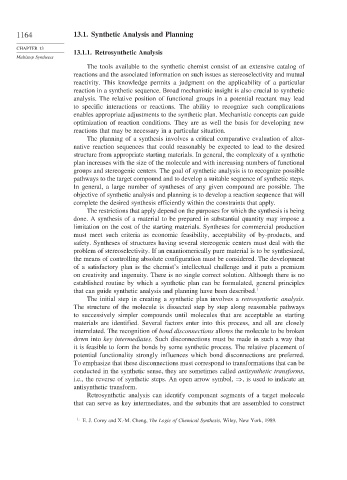Page 1188 - Advanced Organic Chemistry Part B - Reactions & Synthesis
P. 1188
1164 13.1. Synthetic Analysis and Planning
CHAPTER 13
13.1.1. Retrosynthetic Analysis
Multistep Syntheses
The tools available to the synthetic chemist consist of an extensive catalog of
reactions and the associated information on such issues as stereoselectivity and mutual
reactivity. This knowledge permits a judgment on the applicability of a particular
reaction in a synthetic sequence. Broad mechanistic insight is also crucial to synthetic
analysis. The relative position of functional groups in a potential reactant may lead
to specific interactions or reactions. The ability to recognize such complications
enables appropriate adjustments to the synthetic plan. Mechanistic concepts can guide
optimization of reaction conditions. They are as well the basis for developing new
reactions that may be necessary in a particular situation.
The planning of a synthesis involves a critical comparative evaluation of alter-
native reaction sequences that could reasonably be expected to lead to the desired
structure from appropriate starting materials. In general, the complexity of a synthetic
plan increases with the size of the molecule and with increasing numbers of functional
groups and stereogenic centers. The goal of synthetic analysis is to recognize possible
pathways to the target compound and to develop a suitable sequence of synthetic steps.
In general, a large number of syntheses of any given compound are possible. The
objective of synthetic analysis and planning is to develop a reaction sequence that will
complete the desired synthesis efficiently within the constraints that apply.
The restrictions that apply depend on the purposes for which the synthesis is being
done. A synthesis of a material to be prepared in substantial quantity may impose a
limitation on the cost of the starting materials. Syntheses for commercial production
must meet such criteria as economic feasibility, acceptability of by-products, and
safety. Syntheses of structures having several stereogenic centers must deal with the
problem of stereoselectivity. If an enantiomerically pure material is to be synthesized,
the means of controlling absolute configuration must be considered. The development
of a satisfactory plan is the chemist’s intellectual challenge and it puts a premium
on creativity and ingenuity. There is no single correct solution. Although there is no
established routine by which a synthetic plan can be formulated, general principles
that can guide synthetic analysis and planning have been described. 1
The initial step in creating a synthetic plan involves a retrosynthetic analysis.
The structure of the molecule is dissected step by step along reasonable pathways
to successively simpler compounds until molecules that are acceptable as starting
materials are identified. Several factors enter into this process, and all are closely
interrelated. The recognition of bond disconnections allows the molecule to be broken
down into key intermediates. Such disconnections must be made in such a way that
it is feasible to form the bonds by some synthetic process. The relative placement of
potential functionality strongly influences which bond disconnections are preferred.
To emphasize that these disconnections must correspond to transformations that can be
conducted in the synthetic sense, they are sometimes called antisynthetic transforms,
i.e., the reverse of synthetic steps. An open arrow symbol, ⇒, is used to indicate an
antisynthetic transform.
Retrosynthetic analysis can identify component segments of a target molecule
that can serve as key intermediates, and the subunits that are assembled to construct
1
E. J. Corey and X.-M. Cheng, The Logic of Chemical Synthesis, Wiley, New York, 1989.

